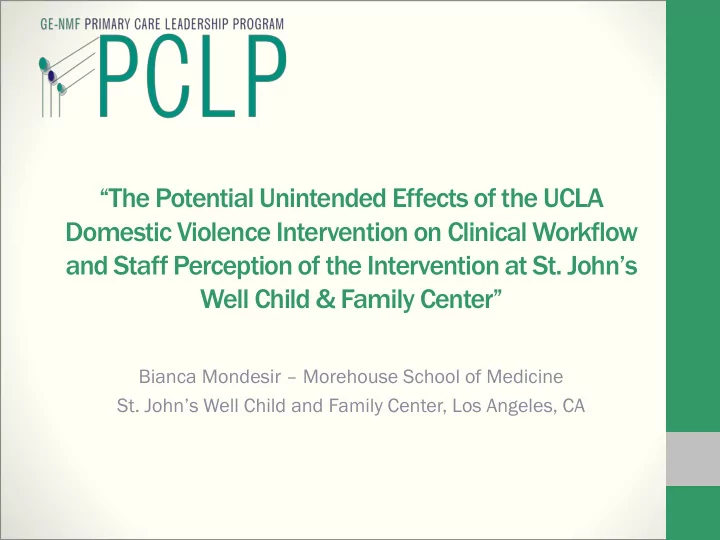

“The Potential Unintended Effects of the UCLA Domestic Violence Intervention on Clinical Workflow and Staff Perception of the Intervention at St. John’s Well Child & Family Center” Bianca Mondesir – Morehouse School of Medicine St. John’s Well Child and Family Center, Los Angeles, CA
Introduction • Due to the recognition that domestic violence is a major health issue and the apparent need to improve patient-physician communication regarding domestic violence, California now enforces laws to increase the identification of domestic violence victims. • In order to strengthen the identification and referral systems for victims of domestic violence in Los Angeles County, SJWCFC partnered with the University of California, Los Angeles (UCLA) to use technology to improve outreach to victims at four of the clinics: Williams, Compton, Magnolia and East Compton. • Although the implementation of the in-language screening video has potential benefits for the patients, it is important to understand the possible unintended effects this intervention would have on an already burden system, where the patient load is great and expendable time is rare.
Background • Domestic violence crosses all demographic and socioeconomic lines, but poor women may be most at risk (Weinbaum et al., 2001) • In the city of Los Angeles alone, 31,081 incidences of domestic violence were reported to the Los Angeles Police Department (LAPD) Bureau in 2012. • Morbidity associated with domestic violence justifies these victims repeated visits to Health Service (Arrendondo- Provecho et al. 2012). • Although the primary care setting is an important site for identification and intervention, there have been challenges in determining how health care professionals can best address this issue in practice (Gutmanis, Beynon, Tutty, Wathen and MacMillian, 2007).
Methodology • William’s Health Center • Five in-depth interviews were conducted with SJWCFC staff members involved with the project to ascertain the St. John’s staff’s perception of the proposed UCLA domestic violence intervention. • Cross-sectional study utilizing a convenience sample to garner data concerning the amount of time patients spent in the exam room with a medical assistant, alone, and with the health care provider. • Observation hours: between the times of 8:00 am and 4:00 pm, Tuesday through Friday for a total of 30-hours. • Ethnographic observation method to collect spatial workflow data • Observation hours: during the hours of 9:00 am and 5:00 pm, Monday through Friday for a total of 40-hours.
Results Interview Themes Time constraints within the center prevent providers from feeling comfortable with the intervention taking place in the exam room Domestic violence does not appear to be a high priority for providers who must deal with more pressing medical issues Providers are already asking their patients about domestic violence when the key indicators of domestic violence are present Some providers do not believe that the issue of domestic violence should be brought up during every single visit � Time� Spent� Time� Spent� Time� Spent� Time� Spend� Waiting� for� with� Medical� Alone� in� the� with� the� Exam� Room� Assistant� in� Exam� Room� Health� Care� from� the� Time� the� Exam� Provider� in� the� of� the� Room� � Exam� Room� � Appointment� � Mean� 46.9� 4.1� 13.0� 9.5� S.D.*� 40.6� 3.8� 9.2� 6.2� � � � Check-in� at� Laboratory� for� � reception� in� the� vitals� or� blood� � Examination� front� waiting� area� work� Room� Front� Back� � Waiting� Waiting� Area� Room�
Discussion • Since the average waiting time is 13 minutes, a 2-6 minute screening video should not greatly effect the amount of time the average patient would have to spend in the examination room if the videos were shown during the period in which the patient is alone in the examine room • If, however, the providers are still required to discuss the video with the patients, then the amount of time the providers spends with the patients might increase. • Providers showed concern about being required to ask their patients about domestic violence during each visit. • A cross-sectional study identifying domestic violence in primary care sought to measure the attitudes of women towards being questioned about domestic violence by general practitioners or practice nurses. In this study, at least 202/1010 (20%) women objected to screening for domestic violence (Richardson, Coid, Petruckevitch, Chung, Moorey, & Feder, 2002).
Recommendations • Because the primary care setting is an ideal place to screen potential domestic violence victims, those involved in health care should have a role in identifying them. • Domestic violence tab included in the social history component in centricity, St. John’s EMR. • Encoded referral should be added to the printed patient instructions given to the patient at the end of the visit • “Warm hand- off” for counseling prior to discharge
Conclusion • The UCLA- St. John’s Well Child and Family Center Domestic Violence Intervention is expected to be very beneficial to the patients and the staff at the center. • In order to truly understand the implications of the intervention on clinical workflow, the effects of it would have to be investigated once it begins. • This leaves the opportunity for further research when it comes to the effect of domestic violence interventions on clinical workflow in centers similar to that of St. John’s.
Acknowledgements • Dr. Farid Hassanpour • Dr. Matthew Ho • Rebecca Sussman • Dr. Beatrice Germain • Laurie Dressler • Jessica Allen • GE- National Medical Fellowships • Primary Care Leadership Program (PCLP)
Recommend
More recommend